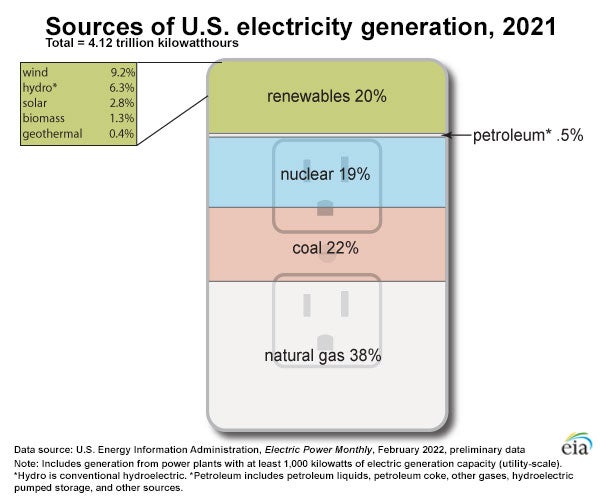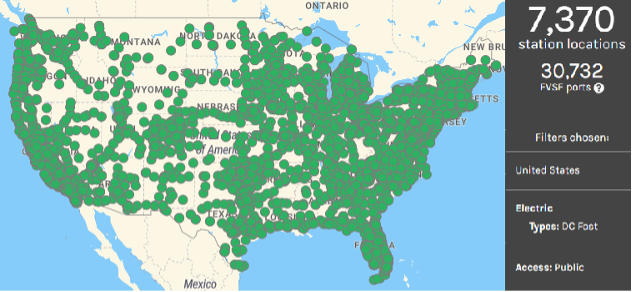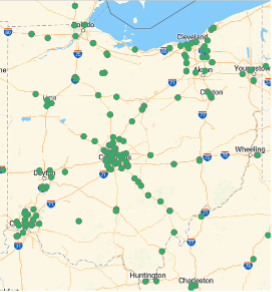On Saturday, May 20 a community event was held at the Hancock-Wood Electric Cooperative warehouse to discuss electric vehicles. We had a good turnout from the community and received great feedback and thoughts from members about electric vehicles.
Using electricity to power vehicles can have emissions benefits as well as improve energy security. During the event members discussed various forms of electricity generation, summarized by the chart below.

One of the biggest questions from the event centered around the logistics of charging an EV or hybrid vehicle. As electric-powered vehicles become more popular, the infrastructure to support them is rapidly expanding. The maps below show the location of charging stations across the United States as well as stations in Ohio.


(Maps courtesy of https://afdc.energy.gov/stations/#/find/nearest).
During the event, we featured two electric vehicle models; the F-150 Lightning ER and the Model Y LR AWD.

Hancock-Wood Electric has developed a way of handling the charging of EV or hybrid vehicles that is ideal for the electricity grid as a whole. Check out our rates for the electric vehicles we featured at our event as an example of how charging rates will work below. Please keep in mind the phrase "your mileage may vary"!
|
RANGE (EPA EST.) |
EST. MI/KWH |
EST. WH/MI |
|
|
F-150 LIGHTNING ER (131 KWH) |
320 |
2.4 |
409 |
|
MODEL Y LR AWD (81 KWH) |
318 |
3.9 |
255 |
|
Cost to Charge |
F-150 LIGHTNING 15% to 80% |
F-150 LIGHTNING 0% to 100% |
MODEL Y 15% to 80% |
MODEL Y 0% to 100% |
|
Hancock-Wood Electric Cooperative On-Peak |
$12.28 |
$18.90 |
$7.60 |
$11.69 |
|
Hancock-Wood Electric Cooperative Off-Peak |
$5.63 |
$8.67 |
$3.48 |
$5.36 |
|
DCFC @ $.36/KWH |
$30.65 |
$47.16 |
$18.95 |
$29.16 |
|
DCFC @ $.48/KWH |
$40.87 |
$62.88 |
$25.27 |
$38.88 |
Hancock-Wood Electric Cooperative’s Time-of-Day pricing offers a 50% discount for charging off-peak between 10 PM – 6 AM. Visit https://hwe.coop/rates for details.
Configure your vehicle to complete charging by 6 AM, rather than to begin charging at 10 PM! This will put less stress on the electricity grid.
|
Cost per Mile |
F-150 LIGHTNING |
F-150 5.0 V8 19MPG @ $3.42 |
MODEL Y |
EDGE 23MPG @ $3.42 |
|
Hancock-Wood Electric Cooperative On-Peak |
$0.06 |
$0.18 |
$0.04 |
$0.15 |
|
Hancock-Wood Electric Cooperative Off-Peak |
$0.03 |
$0.18 |
$0.02 |
$0.15 |
|
DCFC @ $.36/KWH |
$0.15 |
$0.18 |
$0.09 |
$0.15 |
|
DCFC @ $.48/KWH |
$0.20 |
$0.18 |
$0.12 |
$0.15 |
(Charging cost & cost per mile examples are based on manufacturers’ specifications and stated range along with Hancock-Wood Electric's TOD rate).
(Rates calculated based on https://www.plugshare.com/ ).
Like gasoline, the price of electricity fluctuates. Unlike gasoline, a major component in the price of electricity is grid and equipment capacity. One kilowatt-hour delivered from a DC Fast Charger, for example, will cost more than one kilowatt-hour at your home. Likewise with Time-of-Day pricing, on-peak costs more than off-peak.
Other community questions focused on the fuel economy of using electricity to power vehicles. Fuel costs can be reduced significantly in certain use cases due to the high-efficiency nature of electric-drive components.
The fuel economy of EVs and hybrid vehicles are measured differently than that of conventional vehicle. Miles per gallon of gasoline equivalent (MPGe) and kilowatt-hours (kWh) per 100 miles are common metrics to compare the fuel economy of conventional vehicles versus EVs and hybrids. FuelEconomy.gov provides a comparison of the 2021 Toyota Corolla Hybrid and the conventional 2021 Corolla (four-cylinder, automatic). The Toyota Corolla Hybrid has an EPA combined city-and-highway fuel economy estimate of 52 miles per gallon (MPG). The estimate for the conventional 2021 Corolla (four-cylinder, automatic) is 34 MPG. (Information taken from https://afdc.energy.gov/fuels/electricity_benefits.html).
If you're interested in seeing how your vehicle would compare to an EV or hybrid, check out the Find A Car tool on FuelEconomy.gov.
One major benefit that was discussed at the event was how EVs and hybrids compare to conventional vehicles when it comes to emissions. Hybrid vehicles when operating in all-electric mode and EVs produce zero carbon emissions. It is worth noting the emission benefits will depend on the vehicle model and if the vehicle is a hybrid, the hybrid's type of power system. Emission benefits may also be affected by the source of electricity used to charge the vehicle.
The third vehicle featured at the Cars and Coffee event runs off of ethanol fuel. Ethanol fuel is produced from corn and other plant materials and is renewable. There are several different blends of ethanol fuel, the most common being E10 (10% ethanol, 90% gasoline). Within the United States, 94% of ethanol is produced from the starch in corn grain. Energy is required to turn any raw feedstock into ethanol. Ethanol produced from corn demonstrates a positive energy balance, meaning that the process of producing ethanol fuel does not require more energy than the amount of energy contained in the fuel itself.

High blends and low blends of ethanol fuel offer many benefits, such as reducing emissions and improving energy security. Fuel economy and vehicle performance can also be improved by using ethanol fuel. For example, E85 which contains 83% ethanol content has about 27% less energy per gallon than gasoline. This efficiency will lessen as the amount of ethanol decreases.
Ethanol also has a higher octane than traditional gasoline, which can improve vehicle power and overall performance. Indianapolis 500 drivers often fuel their race cars with E98 because of its high octane. The Co-Optimization of Fuels and Engines initiative researched the potential to improve engine efficiency through the use of various ethanol blends and other high-octane biofuels.
Another great benefit of ethanol fuel is that it creates jobs, particularly in rural areas. According to the Renewable Fuels Association, ethanol production in 2021 accounted for more than 73,000 direct jobs across the United States. $52.1 billion of the gross domestic product, and $28.7 billion in household income. (See the 2022 Pocket Guide to Ethanol(PDF)).
Did you know? Low-level blends of E10 or less require no special fueling equipment, and they can be used in any conventional gasoline vehicle. It is also possible to accommodate blends above E10 in existing fueling equipment, however, some equipment needs to be upgraded to comply with the federal code. See the Codes, Standards, and Safety page and the Handbook for Handling, Storing, and Dispensing E85 and Other Ethanol-Gasoline Blends(PDF) for detailed information on compatible equipment.
FFvs (which can operate on E85, gasoline, or a blend of the two) are available nationwide as standard equipment with no incremental cost, allowing them to be a cost-effective option for using alternative fuels. Fueling stations offering E85 (flex fuel) are located in 44 states. Find ethanol (E85) fueling stations in your area.
To learn more about ethanol and other alternative fuels, please visit FuelEconomy.gov, or see the Alternative Fuel and Advanced Technology Vehicles list(PDF).
(Information taken from https://afdc.energy.gov/fuels/ethanol.html).
The Cars and Coffee event was very informational, and we'd love to see you at our next event!
Sources:
https://afdc.energy.gov/fuels/electricity.html
https://afdc.energy.gov/fuels/ethanol.html
